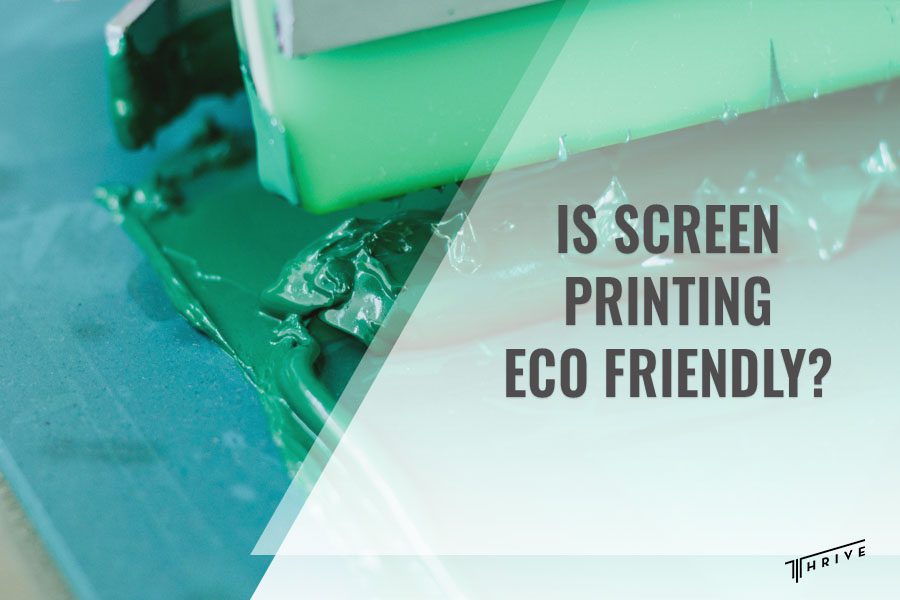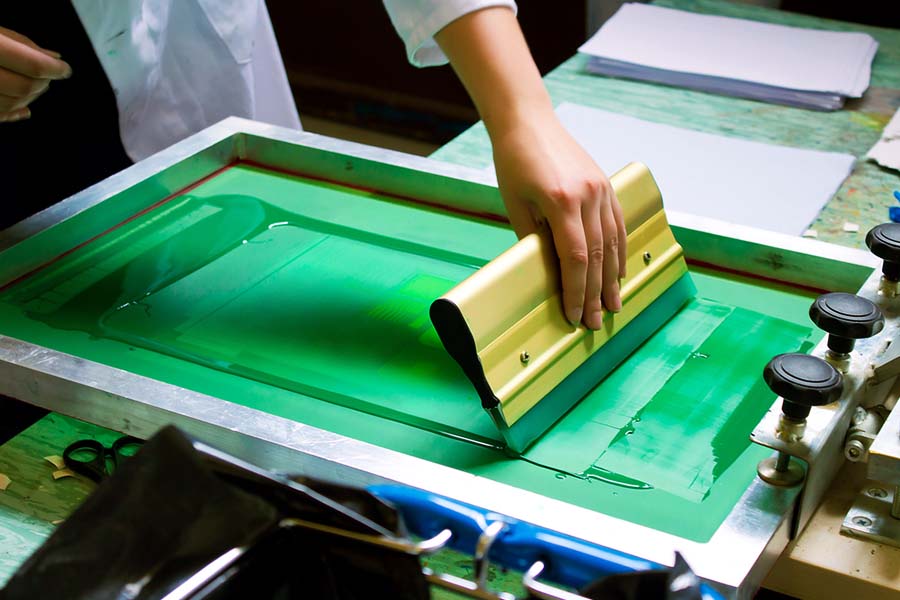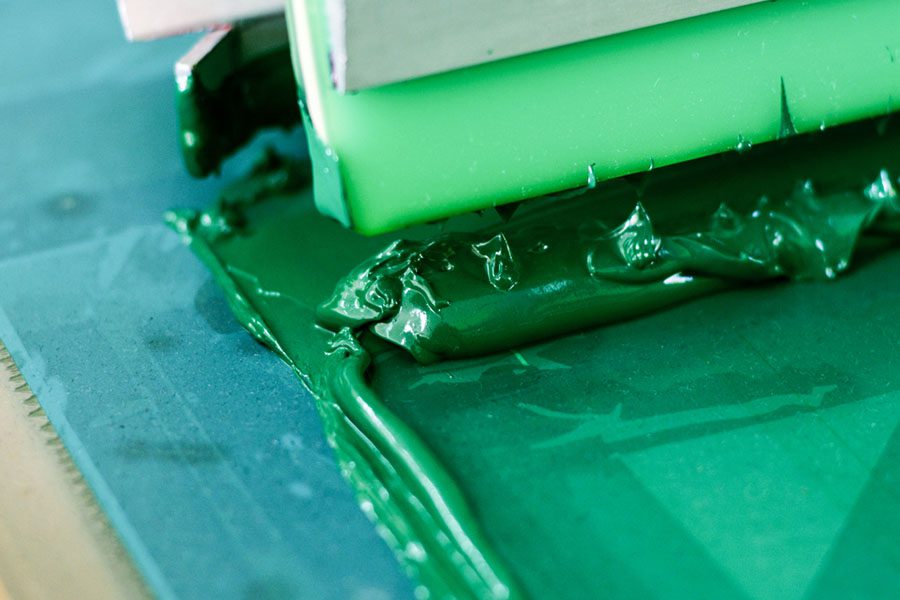
Screen printing is a widely used printing technique for creating bold and vibrant designs. It has an artistic charm and is excellent for printing various designs onto all sorts of surfaces, including apparel, posters, and ceramics. However, beneath the appealing visuals, a significant question arises. Is screen printing eco friendly?
At Thrive Screen Printing, we are committed to protecting the environment, and we adhere to ecologically sound practices. Hence, we will dive into the environmental footprint this popular printing technique leaves. In this post, you will also learn how to create sustainable art and minimize any potential hazards.
Is Screen Printing Eco Friendly?
Environmental consciousness is crucial for protecting the natural resources our earth provides. For this reason, industries are constantly questioned about their practices and scrutinized for their potential influence on the planet.
Printing techniques like screen printing also commonly face questions about their eco-friendliness. From the various printing techniques, we are mostly interested in screen printing and its environmental impact. So, is screen printing environmentally friendly? The environmental impact of this printing technique depends on various factors.
Whether you are considering printing on a small scale or planning bulk screen printing, it is necessary to be mindful of its environmental impact. Let’s explore some concerns and considerations associated with screen printing in the section below.

Challenges and considerations of screen printing
Traditional screen printing techniques rely on several elements that often raise environmental concerns, such as the use of plastisol inks. While known for their durability and vibrancy, they are made with PVC – a petroleum-based ink.
The production of such plastic is energy-intensive and releases harmful chemicals. As a result, it can pose health risks during printing and potentially leach into waterways when disposed of. So, is there an eco friendly screen printing ink?
Water-based ink is a viable alternative to plastisol inks as it doesn’t contain toxic materials like its counterparts. They require less energy for curing, minimize waste, and are easier to clean up while providing a softer feel to garments.
Biodegradable and organic screen printing ink is a sustainable option as it is made from plant and soy-based materials. However, the availability and performance of such inks are still evolving as they are the newest development in the printing sector.
How to do Eco Friendly Screen Printing
Optimizing the usage of inks
Not only choosing eco-friendly inks but also minimizing ink waste is crucial for staying eco-friendly when screen printing. Thus, when printing, we recommend accurately measuring and mixing the amount of ink that you need for each project.
You could reuse leftover inks or combine colors that you already have to get new colors that you can work with. By reducing ink waste, you not only increase sustainability but can also save more in the long run.
The screen used for printing
The screens that you use during the printing process require regular cleaning and maintenance. This is often done with solvents and emulsions, many of which are volatile organic compounds that can cause air pollution and smog formation.
Instead, opt for a more environmentally-friendly cleaning solution. You can also reuse screens multiple times if they are adequately cleaned. Doing so reduces the need to produce new screens that come with metal frames and synthetic mesh.
Use Eco-Friendly Materials
Aside from eco-friendly inks, responsible resource management can contribute to your eco-friendliness. Ensure that you adhere to sustainability practices and regulations that align with your vision and values.
At Thrive Screen Printing, we also recommend choosing sustainable substrates for printing. Opt for materials such as organic cotton, bamboo, or recycled fabrics, as their environmental impact is lower than other options.
If you are packaging your prints, use recycled or biodegradable materials. Such packaging solutions can be a great pathway towards a sustainable business and proper waste management.
Water usage and disposal
Screen printing often involves rinsing screens and garments. Although the amount of water needed depends on the ink and the technique used, a large amount of water usage can generate wastewater and could pollute rivers and streams.
That said, responsible water usage and wastewater disposal are crucial aspects of the environment to consider. Investing in water-efficient equipment and proper wastewater treatment systems can significantly reduce wastage and the environmental impact of the discharged water.
Proper waste management is equally crucial in the process of printing. As a result, we advise you to consider recycling options and systems for your materials in the workplace for responsible waste disposal.
Stay energy-efficient
In order to screen print, you need to use machinery that often consumes a large amount of energy. With this in mind, consider getting energy-efficient equipment designed to reduce the consumption of energy throughout the process. Additionally, use lighting only when necessary and take advantage of the natural light.
The Road of Shifting Towards Eco Friendly Screen Printing
The world has witnessed a growing awareness about the environmental impact of various industries, including printing. As a result, the demand for sustainable business practices is becoming more common among businesses.
More and more businesses and individuals are turning to eco-conscious solutions, like organic screen printing and sustainable ink. Many collaborate with like-minded institutions to share practices, and stay abreast of the trends and innovations.
The shift towards eco friendly practices in the world of screen printing requires effort from both the printers and the consumers. Print operators need to adopt sustainable practices and make adjustments to their printing techniques.
Conversely, consumers need to be willing to use eco-friendly products that will protect the environment. They may choose to support businesses committed to non-polluting and sustainable practices.
While achieving truly eco-friendly screen printing remains a work in progress, the printing industry is heading in the right direction. Innovations and ethical practices hold a promise for a future where printing coexists with a healthy planet.

How we promote eco friendly printing practices
As a team of experienced wholesale printing professionals, we recognize the opportunities to make the process greener. We use non-phthalate inks and biodegradable chemicals during the screen reclaiming process.
At Thrive Screen Printing, we promote ecologically responsible printing and maintain an eco friendly workplace. By choosing sustainable materials and maintaining suitable practices, we are joining the worldwide movement for protecting our planet.
Conclusion
Screen printing can be a powerful printing technique for artistic expression and the creation of sharp and vibrant prints. But is screen printing eco friendly? This is a common question that raises concerns among ecologically conscious individuals.
While the environmental footprint of such printing is ‘not-so-rosy’, there are certain alternatives and deeds that can make significant changes. By adhering to such practices, we can ensure screen printing continues to thrive in an eco friendly world.

Robert Fisher is the founder and CEO of Thrive Screen Printing and brings extensive experience in the screen printing and fulfillment industry.

